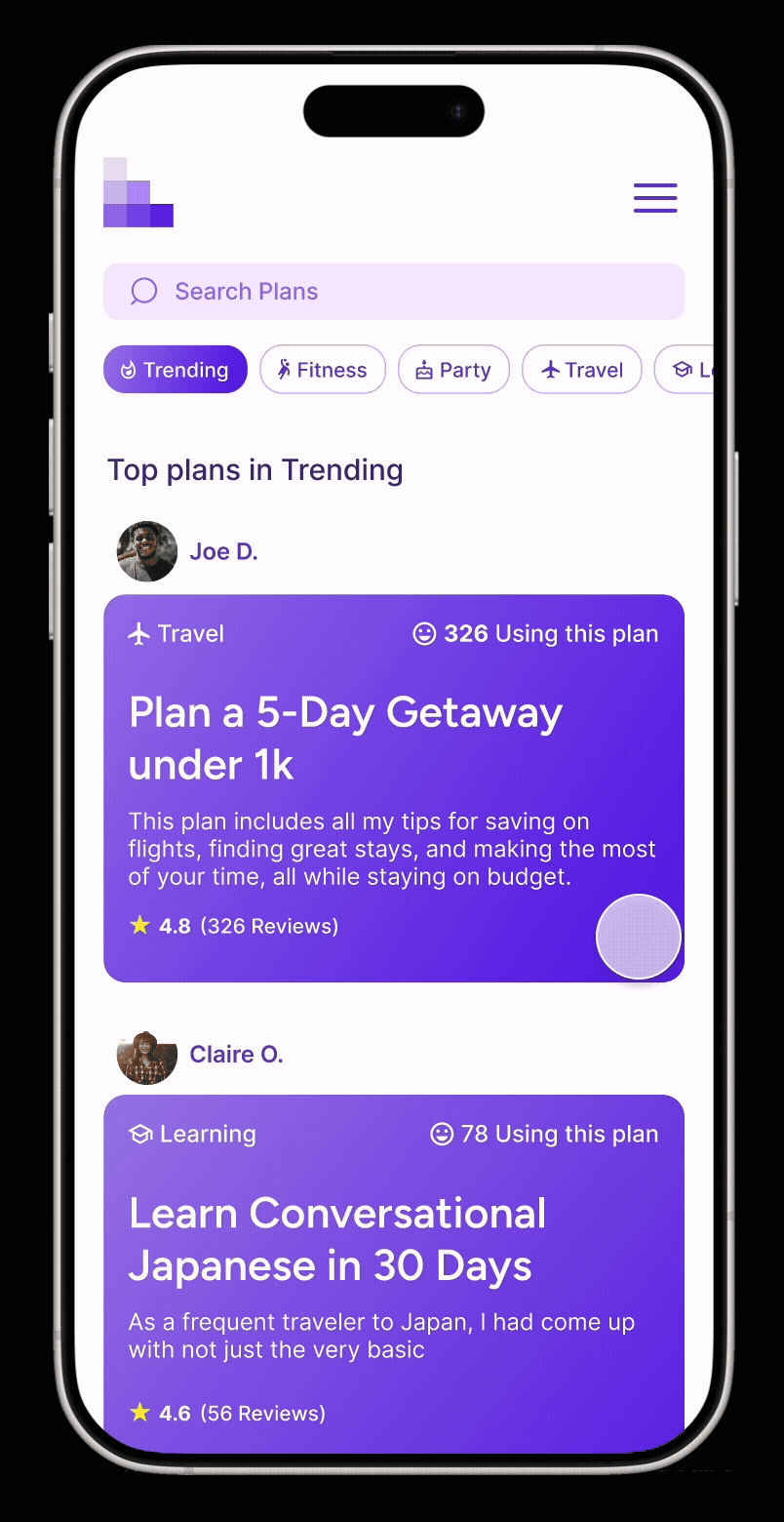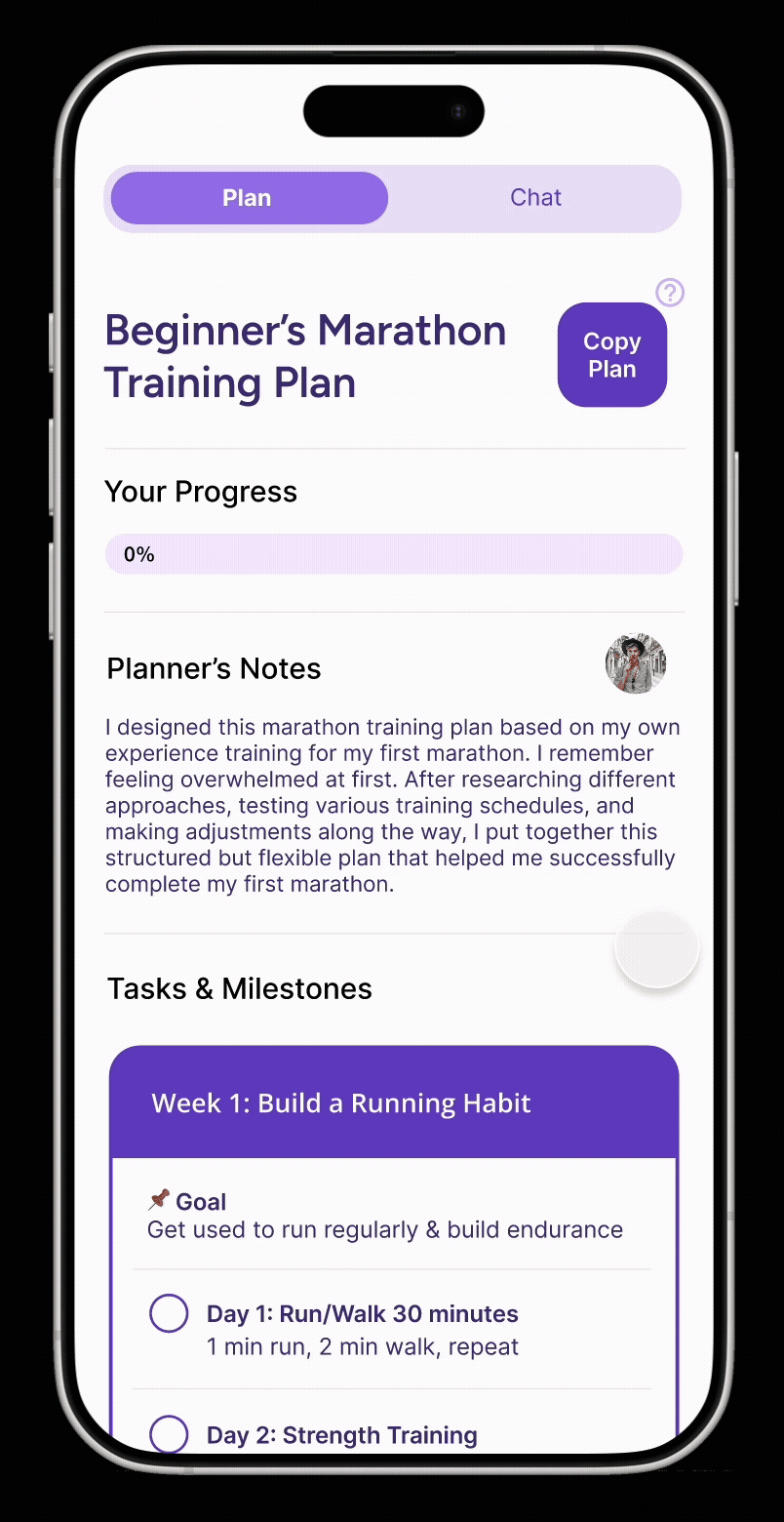LADDER:
ACHIEVE YOUR GOALS WITH PLANS THAT WORKED FOR OTHERS
What if you could see exactly how someone else achieved the goal you're struggling with, and connect with others doing the same thing?
Ladder combines two powerful forces: proven step-by-step systems from real people who succeeded, and social connection to keep you motivated along the way. Instead of struggling alone with vague advice, you get clear direction and community support.
DESIGN APPROACH
A quote from Atomic Habits really stuck with me: 'you don't rise to the level of your goals, you fall to the level of your systems.'
It made me wonder, what if we could actually see other people's systems?
Through my research, I discovered two key problems: isolation kills motivation, and people often feel stuck not because they lack ambition, but because they don't know the next concrete step to take. Most goal apps tackle one or the other, but I realized these problems are connected.
That's what makes Ladder different—it combines proven systems with social connection. Instead of struggling alone with vague advice, you can follow the actual step-by-step system someone else used to succeed. You're not isolated because you're part of a community, and you're not overwhelmed because you have a clear, tested path to follow.
Project Type: High-Fidelity UI Design
Role: User Research, UX/UI, Concept Development
Tools: Figma
Timeline: 3 weeks
DYNAMIC DISCOVERY:
BROWSE REAL SUCCESS STORIES
See goals that people actually accomplished, not just New Year's resolutions that might not work out. Each goal shows you what worked, how long it took, and how other users designed the system that worked for them. You can search up the goal you want to achieve, browse by category or discover something completely new that caught someone else's attention.
I used a card-based layout similar to social feeds because it brings out the community aspect. The star ratings and completion numbers are prominently displayed to build immediate trust.
PLAN OVERVIEW:
GET THE FULL PICTURE FIRST
Before you commit to anything, you can see exactly what you're signing up for. How much time will this really take? What will you actually be doing? Other people who tried it share honest reviews about what worked and what didn't. Plus, you can see who else is currently working on the same goal through the 'Partners in Progress' feature.
I designed this overview page to reduce commitment anxiety. Clear time estimates, honest reviews, and seeing other active participants all help users feel confident before they start. The visual progress bar for 'Partners in Progress' creates an immediate sense of community.
PLAN DETAILS:
FOLLOW THE ACTUAL STEPS
Once you join a plan, you get access to the real system someone used to succeed. Everything is laid out week by week, day by day. Each step unlocks only after you complete the previous one. This keeps you from getting overwhelmed and helps you build momentum alongside others who are following the same journey.
The locked/unlocked visual states tap into gaming psychology. The satisfaction of progression. I used clear checkmarks and subtle progress indicators because completing tasks needs to feel rewarding.
The typography hierarchy guides you to focus on just the next step, not the entire overwhelming plan.
REFLECTION & CONCLUSION
Ladder went through multiple iterations during its development. It started from a simple productivity tool into a platform that responds to deeper emotional and behavioral needs.
As I researched the link between motivation and isolation, it became clear that sustainable progress requires more than just discipline. That's when it clicked: what if people could literally see how others succeeded? Not just “here's my before and after”, but “here's exactly what I did every single day”.
The social connection became just as important as the step-by-step systems. When you can see other people working on the same goal, and when you know someone else figured out a path that actually worked, it makes your own goal feel way less impossible.
The final concept brings together two key forces: social connection to combat the reduced drive that often comes with isolation, and structured, succeeded systems that break goals into manageable, motivating steps.
Future features are planned, users could message the person who created the plan they're following, or connect with others on the same journey for questions and support. As well as the customization of plans to fit their own schedules and workflows, catering to different work flows that work for different people.







